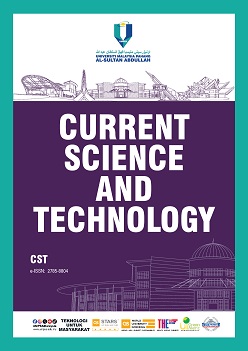Core Gut Microbiome in Patients with Staghorn Calculi in Malaysia
DOI:
https://doi.org/10.15282/cst.v4i2.11909Keywords:
Staghorn calculi , Gut microbiota, Core microbiome , Megamonas funiformisAbstract
Globally, staghorn calculi stone prevalence is 3–5% annually, with a lifetime prevalence of up to 25%. Recurrence rates are 10% within the first year, 50% within 5–10 years, and 75% over 20 years, despite improvements in treatment. This study aimed to profile the gut microbiota in 77 participants, including 37 staghorn calculi patients and 40 healthy individuals, to identify biomarkers linked to staghorn calculi formation. At the phylum level, Firmicutes A and Proteobacteria were more abundant in the staghorn group, comprising 52.86% and 13.65%, respectively. At the species level, staghorn patients had lower levels of Bifidobacterium adolescentis and higher Escherichia and Megamonas funifomis abundances compared to controls. Core microbiome analysis identified Blautia A as the most abundant species in healthy individuals, whereas Megamonas funiformis was exclusive to staghorn patients, suggesting its potential as a disease biomarker. LEfSe analysis confirmed Megamonas funiformis as significantly enriched in staghorn patients (LDA score: -4.46). These findings highlight critical gut microbiome differences that may contribute to staghorn calculi development.
References
[1] H. Satwikananda, M. A. Wiratama, K. T. C. Putri, and D. M. Soebadi, “Renal cell carcinoma in a patient with staghorn stones: A case report,” International Journal of Surgery Case Reports, vol. 110, p. 108678, 2023.
[2] A. M. Nassir, “Prevalence and characterization of urolithiasis in the western region of Saudi Arabia,” Urology Annals, vol. 11, no. 4, p. 347, 2019.
[3] K. Stamatelou and D. S. Goldfarb, “Epidemiology of kidney stones,” Healthcare, vol. 11, no. 3, p. 424, 2023.
[4] I. Klein and J. Gutiérrez-Aceves, “Preoperative imaging in staghorn calculi, planning and decision making in management of staghorn calculi,” Asian Journal of Urology, vol. 7, no. 2, pp. 87–93, 2020.
[5] J. Malone, R. Gebner, and J. Weyand, “Staghorn calculus: A stone out of proportion to pain,” Clinical Practice and Cases in Emergency Medicine, vol. 5, no. 3, p. 360, 2021.
[6] A. Diri and B. Diri, “Management of staghorn renal stones,” Renal Failure, vol. 40, no. 1, pp. 357-362, 2018.
[7] S. L. Daniel, L. Moradi, H. Paiste, K. D. Wood, D. G. Assimos, R. P. Holmes, et al., “Forty years of Oxalobacter formigenes, a gutsy oxalate-degrading specialist,” Applied and Environmental Microbiology, vol. 87, no. 18, p. e00544-21, 2021.
[8] K. R. Perumal, R. H. B. Chua, G. C. Teh, and C. C. M. Lei, “Prevalence of urolithiasis in Sarawak and associated risk factors: An ultrasonagraphy‐based cross‐sectional study,” BJUI Compass, vol. 4, no. 1, pp. 74–80, 2022.
[9] D. W. Kaufman, J. P. Kelly, G. C. Curhan, T. E. Anderson, S. P. Dretler, G. M. Preminger, et al., “Oxalobacter formigenes may reduce the risk of calcium oxalate kidney stones,” Journal of the American Society of Nephrology, vol. 19, no. 6, pp. 1197-1203, 2008.
[10] A. Mohankumar, R. Ganesh, and P. Shanmugam, “Exploring the connection between bacterial biofilms and renal calculi: A comprehensive review,” Journal of Pure and Applied Microbiology, vol. 18, no. 4, pp. 2262-2283, 2024.
[11] QIAGEN, DNeasy® powersoil® kit handbook. 2017 (n.d.). https://www.qiagen.com/cn/resources/-download.aspx?id=5a0517a7-711d-4085-8a28-2bb25fab828a&lang=en
[12] S. W. Siew, M. H. F. Khairi, N. A. Hamid, M. F. F. Asras, and H. F. Ahmad, “Shallow shotgun sequencing of healthcare waste reveals plastic-eating bacteria with broad-spectrum antibiotic resistance genes,” Environmental Pollution, vol. 364, p. 125330, 2025.
[13] N. H. M. Hussin, D. D. Tay, U. A. Zainulabid, M. N. Maghpor, and H. F. Ahmad, “Harnessing next-generation sequencing to monitor unculturable pathogenic bacteria in the indoor hospital building,” The Microbe, vol. 4, p. 100163, 2024.
[14] Nor Husna Mat-Hussin, Shing Wei Siew, Mohd Norhafsam Maghpor, Han Ming Gan, & Hajar Fauzan Ahmad. (2024). “Method for detection of pathogenic bacteria from indoor air microbiome samples using high-throughput amplicon sequencing,” MethodsX, vol. 12, p. 102636, 2024.
[15] A. Yunus, N. M. Mokhtar, R. A. R. Ali, S. M. A. Kendong, and H. F. Ahmad, “Methods for identification of the opportunistic gut mycobiome from colorectal adenocarcinoma biopsy tissues,” MethodsX, vol. 12, p. 102623, 2024.
[16] H. F. Ahmad, D. D. Tay, S. W. Siew, and M. N. Razali, “Metadata analysis for gut microbiota between indoor and street cats of Malaysia,” Current Science and Technology, vol. 1, no. 1, pp. 56–65, 2021.
[17] S. S. Wei, C. M. Yen, I. P. G. Marshall, H. Abd Hamid, S. S. Kamal, D. S. Nielsen, et al., “Gut microbiome and metabolome of sea cucumber (Stichopus ocellatus) as putative markers for monitoring the marine sediment pollution in Pahang, Malaysia,” Marine Pollution Bulletin, vol. 182, p. 114022, 2022.
[18] S. W. Siew, S. M. Musa, N. A. Sabri, M. F. F. Asras, and H. F. Ahmad, “Evaluation of pre-treated healthcare wastes during COVID-19 pandemic reveals pathogenic microbiota, antibiotics residues, and antibiotic resistance genes against beta-lactams,” Environmental Research, vol. 219, p. 115139, 2022.
[19] J. Fu, J. Shan, Y. Cui, C. Yan, Q. Wang, J. Han, et al., “Metabolic disorder and intestinal microflora dysbiosis in chronic inflammatory demyelinating polyradiculoneuropathy,” Cell & Bioscience, vol. 13, no. 1, p. 6, 2023.
[20] L. B. Olvera-Rosales, A. E. Cruz-Guerrero, E. Ramírez-Moreno, A. Quintero-Lira, E. Contreras-López, J. Jaimez-Ordaz et al. “Impact of the gut microbiota balance on the health–disease relationship: The importance of consuming probiotics and prebiotics,” Foods, vol. 10, no. 6, p. 1261, 2021.
[21] S. Feranchuk, N. Belkova, U. Potapova, D. Kuzmin, and S. Belikov, “Evaluating the use of diversity indices to distinguish between microbial communities with different traits,” Research in Microbiology, vol. 169, no. 4-5, pp. 254–261, 2018.
[22] I. Sharon, N. M. Quijada, E. Pasolli, M. Fabbrini, F. Vitali, V. Agamennone, et al., “The core human microbiome: does it exist and how can we find it? A critical review of the concept,” Nutrients, vol. 14, no. 14, p. 2872, 2022.
Downloads
Published
Issue
Section
License
Copyright (c) 2024 The Author(s)

This work is licensed under a Creative Commons Attribution-NonCommercial 4.0 International License.



